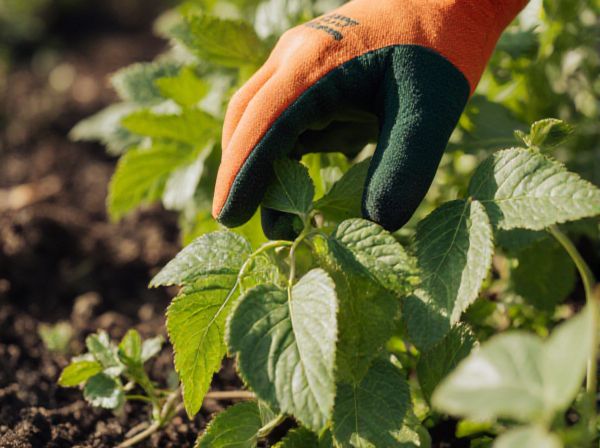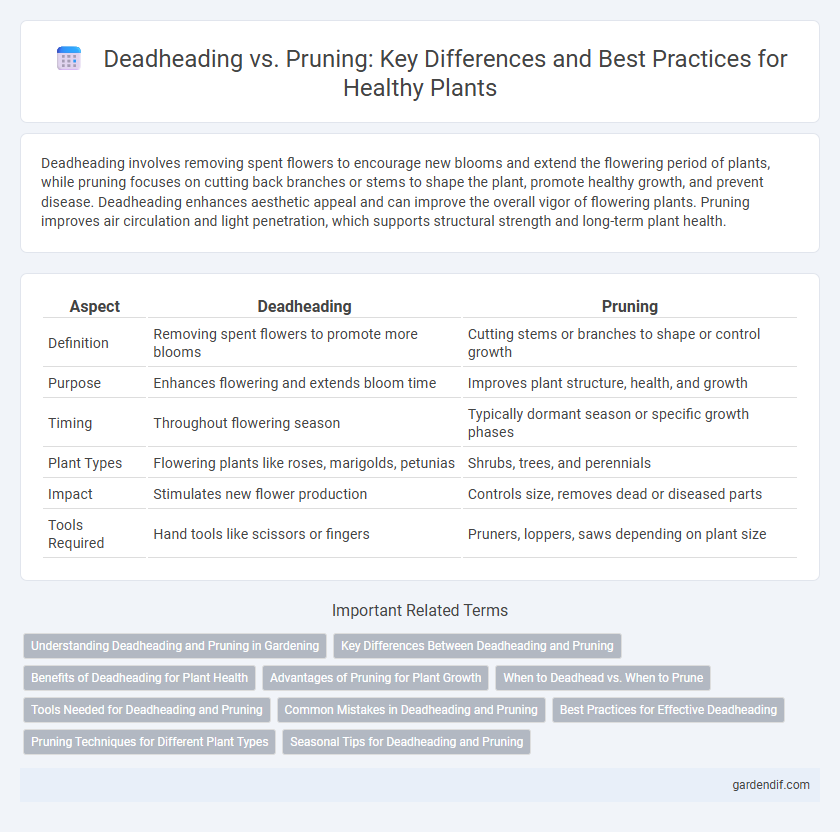
Deadheading vs Pruning Illustration
Deadheading involves removing spent flowers to encourage new blooms and extend the flowering period of plants, while pruning focuses on cutting back branches or stems to shape the plant, promote healthy growth, and prevent disease. Deadheading enhances aesthetic appeal and can improve the overall vigor of flowering plants. Pruning improves air circulation and light penetration, which supports structural strength and long-term plant health.
Table of Comparison
| Aspect | Deadheading | Pruning |
|---|---|---|
| Definition | Removing spent flowers to promote more blooms | Cutting stems or branches to shape or control growth |
| Purpose | Enhances flowering and extends bloom time | Improves plant structure, health, and growth |
| Timing | Throughout flowering season | Typically dormant season or specific growth phases |
| Plant Types | Flowering plants like roses, marigolds, petunias | Shrubs, trees, and perennials |
| Impact | Stimulates new flower production | Controls size, removes dead or diseased parts |
| Tools Required | Hand tools like scissors or fingers | Pruners, loppers, saws depending on plant size |
Understanding Deadheading and Pruning in Gardening
Deadheading is the selective removal of spent flowers to encourage continuous blooming and maintain plant appearance, while pruning involves cutting back branches or stems to shape plants, remove diseased parts, and improve overall health. Effective deadheading boosts flowering plants such as roses, marigolds, and petunias by redirecting energy from seed production to new blooms. Pruning techniques vary by plant type and season, targeting shrubs, trees, and perennials to enhance growth, air circulation, and light penetration.
Key Differences Between Deadheading and Pruning
Deadheading involves removing spent flowers to encourage new blooms and prolong flowering periods, primarily targeting annuals and perennials. Pruning encompasses cutting back branches, stems, or roots to shape plants, remove diseased tissue, and promote overall health and growth, often applied to shrubs and trees. While deadheading focuses on enhancing floral display and bloom longevity, pruning targets structural improvement and plant vitality.
Benefits of Deadheading for Plant Health
Deadheading removes spent flowers, encouraging plants to redirect energy toward new growth and prolonged blooming cycles. This process reduces the risk of diseases by preventing seed formation and minimizing fungal infections on decaying blooms. Enhanced air circulation and improved light penetration after deadheading promote overall plant vigor and health.
Advantages of Pruning for Plant Growth
Pruning promotes healthier plant growth by removing dead or diseased branches, which enhances air circulation and light penetration. It stimulates new growth and helps maintain the plant's shape and structure, leading to increased flowering and fruit production. Proper pruning also reduces the risk of pest infestations and plant stress, supporting long-term vitality.
When to Deadhead vs. When to Prune
Deadheading is ideal for removing spent flowers to encourage continuous blooming, typically done during the flowering season. Pruning should be performed during the plant's dormant period or after the flowering cycle to shape the plant and promote healthy growth. Timing deadheading or pruning correctly enhances plant vigor and prolongs blooming periods.
Tools Needed for Deadheading and Pruning
Deadheading requires simple tools such as hand pruners or garden scissors to remove spent flowers and promote continuous blooming. Pruning often involves more robust equipment like bypass pruners, loppers, and pruning saws to trim branches and shape plants effectively. Proper tool selection enhances plant health by enabling precise cuts and minimizing damage.
Common Mistakes in Deadheading and Pruning
Common mistakes in deadheading include cutting too close to the new growth, which can damage the plant and hinder blooming, and leaving spent flowers, which wastes energy the plant could use for new growth. In pruning, errors often involve removing too much foliage at once, stressing the plant, or pruning at the wrong time of year, which can reduce flowering and overall health. Proper knowledge of plant species' growth habits and timing is crucial to avoid these errors and promote vigorous, healthy plants.
Best Practices for Effective Deadheading
Deadheading involves the selective removal of spent flowers to encourage continuous blooming and prevent seed formation, enhancing plant vigor and aesthetic appeal. Best practices include using clean, sharp tools to cut just above a set of healthy leaves or buds, ensuring remaining stems support new growth. Regular deadheading promotes energy redirection from seed production to flower development, resulting in prolonged flowering periods and healthier plants.
Pruning Techniques for Different Plant Types
Pruning techniques vary significantly depending on the plant type, with deciduous trees benefiting from structural pruning to enhance growth and fruit production, while evergreen shrubs often require light trimming to maintain shape and density. For flowering plants, selective pruning encourages blooming by removing spent flowers and directing energy towards new growth. Herbaceous perennials typically need rejuvenation pruning in early spring to remove dead material and stimulate vigorous regeneration.
Seasonal Tips for Deadheading and Pruning
Deadheading involves removing spent flowers to encourage continuous blooming, especially during spring and summer when many perennials peak in growth. Pruning is best performed in late winter or early spring to reshape plants and promote healthy development before the active growing season begins. Seasonal timing is crucial: deadhead regularly throughout the flowering period, while pruning should be limited to dormant phases to prevent stress and disease.
Deadheading vs Pruning Infographic

 gardendif.com
gardendif.com